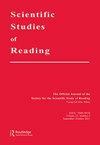What is the letter é?
IF 2.9
2区 教育学
Q1 EDUCATION & EDUCATIONAL RESEARCH
引用次数: 17
Abstract
ABSTRACT Most orthographies contain both accented and non-accented vowels. But are they processed as variants of the same letter unit or as separate abstract units? Recent research in French has revealed that accented vowels seem to be processed as separate units. Here we examined whether this phenomenon is universal or language-specific. We chose Spanish because, unlike French, accented and non-accented vowels only convey stress information. We conducted a masked priming alphabetic decision experiment and a masked priming lexical decision experiment, each with three priming conditions (identity, visually similar, visually dissimilar). Results showed an advantage of the visually similar over the visually dissimilar condition. Furthermore, for non-accented primes, the visually similar condition was as effective as the identity condition. Thus, these findings suggest that: 1) accented and non-accented vowels share their abstract letter representations in Spanish; and 2) the nature of orthographic representations is molded by the characteristics of each language.字母是什么?
摘要大多数正字法同时包含重音元音和非重音元音。但是,它们是作为同一字母单位的变体处理的,还是作为单独的抽象单位处理的?最近对法语的研究表明,重音元音似乎是作为单独的单元处理的。在这里,我们研究了这种现象是普遍的还是特定于语言的。我们选择西班牙语是因为与法语不同,重音元音和非重音元音只传达重音信息。我们进行了一个掩蔽启动字母决策实验和掩蔽启动词汇决策实验,每个实验都有三个启动条件(同一性、视觉相似性和视觉不相似性)。结果表明,视觉相似的条件比视觉不相似的条件有优势。此外,对于非重音素数,视觉相似条件与同一条件一样有效。因此,这些发现表明:1)重音元音和非重音元音在西班牙语中有着共同的抽象字母表示;以及2)正字法表示的性质是由每种语言的特征塑造的。
本文章由计算机程序翻译,如有差异,请以英文原文为准。
求助全文
约1分钟内获得全文
求助全文
来源期刊

Scientific Studies of Reading
Multiple-
CiteScore
7.20
自引率
2.70%
发文量
26
期刊介绍:
This journal publishes original empirical investigations dealing with all aspects of reading and its related areas, and, occasionally, scholarly reviews of the literature, papers focused on theory development, and discussions of social policy issues. Papers range from very basic studies to those whose main thrust is toward educational practice. The journal also includes work on "all aspects of reading and its related areas," a phrase that is sufficiently general to encompass issues related to word recognition, comprehension, writing, intervention, and assessment involving very young children and/or adults.
 求助内容:
求助内容: 应助结果提醒方式:
应助结果提醒方式:


